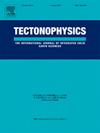Applying and validating Coulomb rate-and-state seismicity models in acoustic emission experiments
IF 2.7
3区 地球科学
Q2 GEOCHEMISTRY & GEOPHYSICS
引用次数: 0
Abstract
A central goal of laboratory seismology is to infer large-scale seismic processes from small-scale experiments, with acoustic emissions (AE) being a common observable. These signals, indicative of microfracturing, slip localization, and damage evolution, are often paralleled with earthquakes to understand seismic behaviors. This study challenges traditional perspectives by applying Coulomb rate-and-state seismicity theory, originally developed for earthquake clustering, to AE experiments. This theory maps stressing history to seismicity rates using rate-and-state friction, however, its validity under controlled experimental conditions remains an open question. We conducted four experiments on a sawcut sample of red felser sandstone, representing a fault under variable stress conditions. Adjustments in loading rates and initial conditions revealed that, while a single free parameter —related to the direct effect—should suffice, a rescaling of the model by 1.5 to 2.2 was necessary for fitting the data. Differences in values across experiments appeared mostly non-systematic, and partial data usage did not yield consistently systematic parameter migrations. These findings suggest that fault microstructure may complexly alter parameter values during loading beyond what is accounted for in the Coulomb rate-and-state theory. Nonetheless, with the introduction of the scaling parameter, the Coulomb rate-and-state theory effectively captures the fundamental aspects of AE responses to complex controlled loading histories.
库仑率态地震活动性模型在声发射实验中的应用与验证
实验室地震学的一个中心目标是从小规模的实验中推断出大规模的地震过程,声发射(AE)是一种常见的观察结果。这些指示微压裂、滑动定位和损伤演化的信号通常与地震并行,以了解地震行为。本研究通过将库仑速率和状态地震活动理论应用于声发射实验,挑战了传统观点。库仑速率和状态地震活动理论最初是为地震聚类而开发的。该理论利用速率-状态摩擦将应力历史映射到地震活动率,然而,其在受控实验条件下的有效性仍然是一个悬而未决的问题。我们对红色felser砂岩的锯切样品进行了四次实验,代表了可变应力条件下的断层。加载率和初始条件的调整表明,虽然与直接效应相关的单个自由参数a应该足够了,但为了拟合数据,需要将模型重新缩放1.5至2.2。实验值的差异大多是非系统的,部分数据的使用并没有产生一致的系统参数迁移。这些发现表明,在加载过程中,故障微观结构可能复杂地改变参数值,超出了库仑速率-状态理论的解释范围。尽管如此,随着尺度参数的引入,库仑速率和状态理论有效地捕获了复杂受控加载历史声发射响应的基本方面。
本文章由计算机程序翻译,如有差异,请以英文原文为准。
求助全文
约1分钟内获得全文
求助全文
来源期刊

Tectonophysics
地学-地球化学与地球物理
CiteScore
4.90
自引率
6.90%
发文量
300
审稿时长
6 months
期刊介绍:
The prime focus of Tectonophysics will be high-impact original research and reviews in the fields of kinematics, structure, composition, and dynamics of the solid arth at all scales. Tectonophysics particularly encourages submission of papers based on the integration of a multitude of geophysical, geological, geochemical, geodynamic, and geotectonic methods
 求助内容:
求助内容: 应助结果提醒方式:
应助结果提醒方式:


